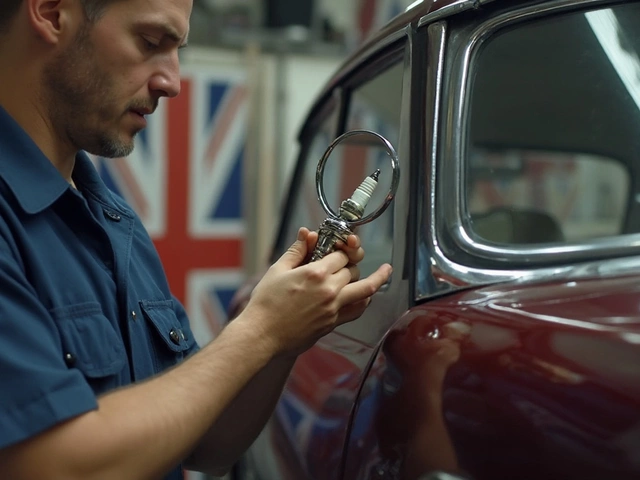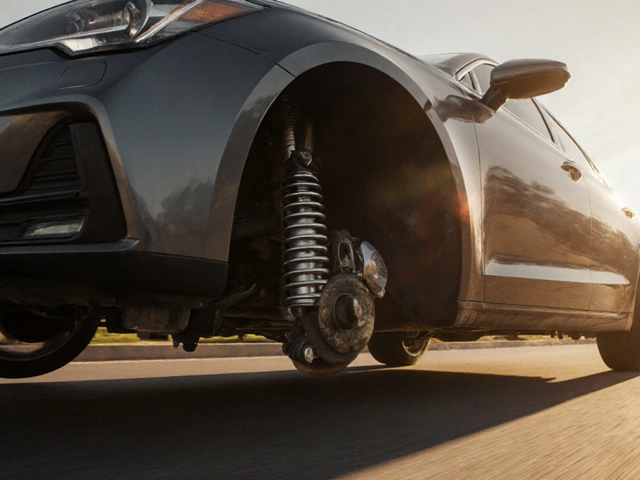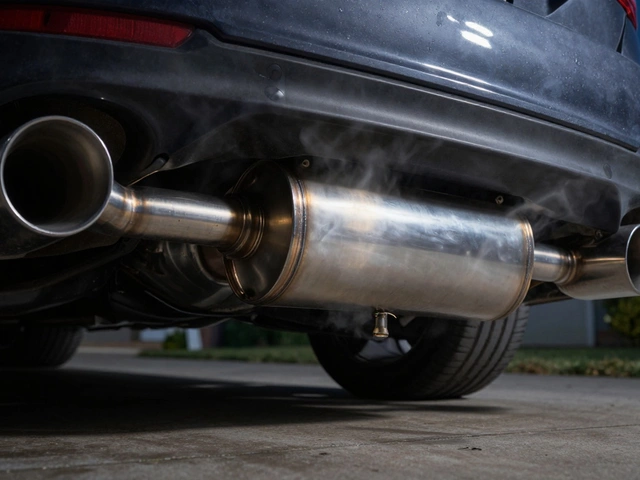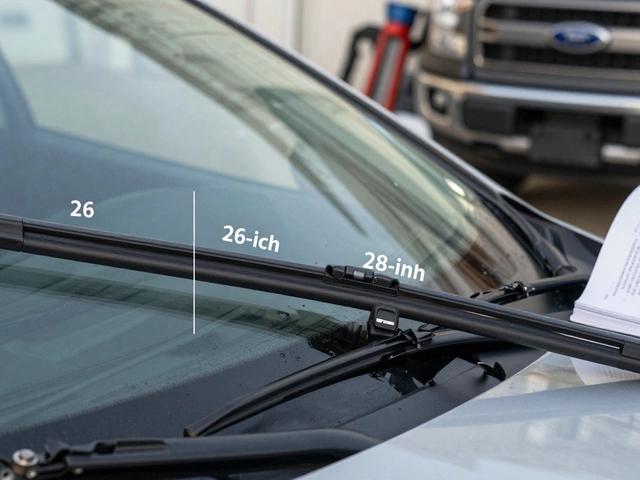As you glide down the road, your car's suspension system quietly works its magic, ensuring you enjoy a smooth journey. Central to this system are the shocks and struts, which might be more important than they seem at first glance. They do far more than just keep your ride comfortable; they're essential for maintaining control and safety.
Have you been hearing unsettling noises while driving, or perhaps noticing a bit more bounce than usual? It's possible that your suspension parts are not what they used to be. Recognizing the need to replace shocks or struts can save you more than just a bumpy ride—it can protect your wallet and your well-being.
Let’s dive into how you can tell if it’s time to consider swapping out those old shocks or struts for new ones, and learn some easy methods to check their condition at home. Whether you're a seasoned driver or somewhat new to car maintenance, this guide will help you keep your vehicle in top shape.
- Understanding Shocks and Struts
- Signs Your Shocks or Struts Need Replacement
- Simple Tests You Can Do at Home
- The Risks of Ignoring Worn Suspension Parts
- Tips for Choosing Replacement Parts
Understanding Shocks and Struts
Your vehicle's shocks and struts may appear like silent players in the automotive world, but their roles are vital for both comfort and control. Essentially, they are key components of your car's suspension system, working tirelessly to dampen the oscillations from the road as you drive. Shocks are fundamentally absorbers that help in minimizing the bounce when you hit an irregularity, while struts are more complex units that include a coil spring for structural support as well as damping functions. Each of these components operates hand-in-hand to ensure you don't feel like you're driving on Mars. But did you know that a typical shock absorber will compress and extend millions of times during its lifespan? This constant movement is why shocks and struts require periodic attention to keep in peak condition.
In many modern vehicles, struts are integrated into a structural system providing support to the chassis, which makes them a bit like the framework of a building. They are pivotal in maintaining correct wheel alignment and adjusting to variations in the vehicle's load or the contours of the road. This structural role means that struts often wear out faster than some might expect. A fascinating fact comes from a study by the National Highway Traffic Safety Administration, which suggests that suspension-related issues contribute to nearly one-third of all vehicular accidents annually, highlighting the critical need for regular checks and maintenance. As a rule of thumb, it's vital to note: while all struts are shocks, not all shocks are struts. Understanding this key difference helps in diagnosing which part of your vehicle may need attention.
According to a respected automotive expert, "Properly functioning shocks and struts are indispensable for safe handling and braking efficiency. They control unwanted spring motion, which is vital—especially during emergency maneuvers." This underscores how crucial these seemingly mundane parts are to your overall safety behind the wheel.
Components and Makeup
Inside a conventional shock absorber, you'll find a piston moving up and down within a tube filled with hydraulic fluid. This fluid is the unsung hero responsible for converting kinetic energy from the motion into heat, thus stabilizing your vehicle’s ride. Meanwhile, when it comes to struts, they often contain a coil spring that supports the vehicle’s weight while dampening the ride. Their dual role, combining spring and damper, means they're highly intricate pieces of engineering. In effect, the absence or malfunction of these components could lead to tire wear, poor steering, and compromised road safety.
Manufacturers often design precise suspension systems that consider the unique balance required for different vehicles, whether it's a sleek sports car or a rugged SUV. This means the lifespan can vary significantly. Some vehicle experts recommend a road test every 50,000 miles to check the health of your shocks and struts. Regular inspections help catch any wear early, ensuring you avoid unpleasant surprises down the line. For those who enjoy digging into the details, remember that maintaining proper functionality in these suspension parts can impact everything from fuel efficiency to tire longevity, affecting your car maintenance routine significantly.
Signs Your Shocks or Struts Need Replacement
Driving is something most of us do every day without much thought, yet it's a complex activity that depends heavily on the condition of our car's crucial components. Among these unsung heroes are the shocks and struts that make the drive not just pleasant but safe. But how do we know when it's time to replace these vital parts? One of the easiest signs to spot is a noticeably rough ride. If every bump in the road seems more pronounced than it used to, it could be the shocks or struts have worn down to the point they're no longer absorbing the shocks of the road. You might notice the car bouncing excessively, particularly after passing over speed bumps or potholes.
Another telltale sign that your suspension system could be crying out for help is increased stopping distance. As you apply your brakes, the car should stop efficiently and conveniently. If it feels like it's taking longer and there's a noticeable shift in how the car responds, often pitching forward, it could indicate that the shocks or struts are struggling to hold the vehicle steady during braking. This is not just annoying, it can actually be dangerous, especially in emergency situations.
“Your vehicle must stay connected to the road, especially in adverse conditions. Shocks and struts help to maintain that critical contact.” - Consumer Reports
Visible signs of leakage are another indicator. Shocks and struts are hydraulic components, meaning they're filled with a special fluid that does much of the dampening work. Should you notice oily residue around them, this could be a sign that the seal has failed. Fluid leakage reduces their effectiveness, rendering them almost useless over time. It's important to inspect them periodically to catch early signs of a problem. This can often be seen by checking the ground under your vehicle or simply looking under the car for any damp patches where the suspension is located.
Uneven tire wear could also imply suspension issues. When the tires seem to have more wear on one side than the other, despite regular alignments, it's often an indicator that the suspension isn't holding the wheels steady, leading to uneven wear patterns. This is typically coupled with noise, such as clunking or knocking, especially when driving over rough surfaces, bumps, or while cornering. These sounds suggest that the suspension components might be loose or worn out, leading to extra movement that shouldn't be there.
Finally, consider handling difficulties—not always the easiest to spot, especially on long straight highways, but noticeable if the vehicle sways or leans excessively while cornering. If it feels as though you're wrestling with the car to keep it steady, the shocks or struts may need attention. A vehicle should return to its normal state almost instantaneously after any maneuver or adjustment, so anything else can be a strong sign something is amiss.

Simple Tests You Can Do at Home
Testing your car's shocks and struts right in your own driveway can be both satisfying and insightful. The process isn't overly complicated, and often requires no more than a keen eye and a few simple tools. When you perform these tests, you're not just keeping tabs on your suspension system; you're getting ahead of potential problems that could escalate into larger issues if ignored. It’s about maintaining control over your vehicle’s health, one small step at a time.
One well-known method for assessing the health of your shocks and struts is the 'bounce test'. This involves applying downward pressure on the corner of the vehicle above each wheel and then quickly releasing it. Observe how the car responds. A healthy shock or strut should only allow the vehicle to bounce back once, maybe twice. An excess of bouncing usually indicates a need for replacement. And remember, what you’re looking for is a firm response, not a wobbly dance.
Another handy tip is the visual inspection. Take a flashlight and closely examine the shocks and struts for leaks, dents, or any visible cracks. Leaks often show up as oily stains on these components and are a clear signal that they might be nearing the end of their lifespan. If you spot something out of the ordinary, it may be time to consult a professional, or at least, keep an eye on that area for further changes.
"Regular maintenance not only extends the life of your vehicle's components but also improves its performance," advises the Car Talk blog, renowned for its automotive wisdom over the years.
While you’re already on your knees checking your suspension parts, it's a good opportunity to also look at the tires. Uneven tire wear can be a side effect of faulty shocks or struts, as these components directly contribute to your car's handling. If the tires are bald on one side, or the tread seems more worn out on certain spots, it might not merely be the tires themselves but an indicator of suspension trouble.
For those who enjoy an even deeper dive, using a pry bar or similar tool to gently lift the vehicle by the frame (not the body) can reveal more about your suspension. Listen for strange sounds or creaking that suggest loose or worn components. This step needs a bit more caution, so always ensure safety first and maybe try it under the guidance of someone with more experience if you’re new to such checks.
If you're tech-savvy, you might look into apps or devices that sync with your car to provide diagnostic reports. While they won’t provide a hands-on test, they can give insights based on your car's computer systems, which might detect issues related to shocks and struts indirectly. This modern solution makes the whole process a bit more interactive and adds confidence to any decision to replace parts.
And as you perform these tests, remember each action contributes to a safer driving experience. A little time spent on checks can make a huge difference in how your vehicle handles not just straight paths but also trickier terrains. These simple tests empower you to make informed decisions, ensuring your drives remain smooth and secure.
The Risks of Ignoring Worn Suspension Parts
Ignoring worn suspension parts like shocks and struts can lead to several safety hazards that can affect both you and your vehicle. When these components become worn, they can no longer efficiently absorb road shocks, leading to an uncomfortable and unstable ride. This could also result in longer stopping distances as your tires lose contact with the road, crucial in emergency braking situations. Additionally, worn shocks can cause uneven tire wear, necessitating premature tire replacements that increase your car maintenance costs. The constant jarring could also lead to damage in other parts of the vehicle's undercarriage, causing a domino effect of repair needs.
Furthermore, the mishandling of a car due to defective shocks or struts becomes apparent in sharp turns, where excessive body roll can increase the risks of losing control. The vehicle might sway or dip on corners and curves which undermines your steering precision and vehicle stability. The stability of your car is also at stake with increased sway, which might go unnoticed when driving at low speeds but reveals itself drastically during highway driving, potentially resulting in dangerous situations. This insidious problem could escalate with such subtleness that by the time a driver notices, the shock absorbers are completely gone.
"Worn suspension greatly impacts your ability to control the vehicle, particularly during sudden stops or turns," says automotive expert John Doe of AutoTech Safety Institute. "Many drivers underestimate this component's importance, which leads to avoidable accidents."Trusting the roadworthiness of your vehicle means acknowledging these risks. Beyond just safety concerns, the cost of ignoring these problems is, more often than not, more significant than addressing them upfront. Remember that while they'd seemingly save cash by delaying repairs, they risk incurring higher costs of potential emergencies and more profound vehicle damage. This kind of procrastination tends to come back full circle when least expected, causing drivers to ultimately confront unnecessary, elevated expenditures.
To drive home these points, let's examine some revealing insights. A study by the Car Safety Foundation found that in vehicles with worn suspension systems, there was a 15% increase in lane deviation incidents. This crucial study highlights the lack of stability and control that worn shocks or struts madate on unsuspecting commuters each year. To help avert these significant risks, it’s recommended to conduct regular checks and maintenance, which prevent minor problems from escalating. Your vigilance not only preserves your wallet but also fortifies your peace of mind on the road.

Tips for Choosing Replacement Parts
Deciding on the right replacement parts for your car's suspension can feel like a daunting task. Yet, with a little insight and careful consideration, it doesn’t have to be an overwhelming experience. When it comes to choosing shocks or struts, there are several factors to keep in mind. First and foremost, always consult your vehicle's manual. It contains the specifications recommended by the manufacturer, which can save you from costly mistakes. Most vehicles are designed with particular parts and configurations in mind, ensuring optimal performance and compatibility. Deviating from these recommendations can sometimes lead to less-than-ideal outcomes, potentially impacting your car's ride quality and safety.
Another critical consideration is the type of driving you primarily engage in. If you use your vehicle for city driving, with mostly smooth roads and minimal load, standard replacement parts may suffice. However, for those who frequently travel on rougher terrains or carry heavy loads, heavy-duty shocks or struts might be a more appropriate choice. These components are built to endure greater stress, providing added durability and stability. In a 2023 survey conducted by the Car Care Council, it was found that drivers who matched their suspension components to their specific driving needs reported fewer issues over time.
To make an informed purchase, be sure to research both OEM (Original Equipment Manufacturer) and aftermarket options. OEM parts are designed by the vehicle’s manufacturer, guaranteeing a fit that's akin to the original. Meanwhile, aftermarket parts sometimes offer enhancements that might suit your preferences better, such as improved performance or longevity at potentially lower prices. It's important to weigh the pros and cons of each category. According to Lindsey Marshall, a senior analyst at AutoTrends Magazine, "While OEM parts ensure compatibility, aftermarket options allow for personalization and can lead to enhanced driving experiences."
Befriend customer reviews and ratings from fellow drivers. These can provide genuine insights that brochures and websites might not cover. Fellow car enthusiasts often share valuable firsthand experiences, offering advice on installation challenges or performance quirks. Additionally, consider longevity and warranties offered by manufacturers. These warranties serve as an assurance of quality and can offer peace of mind. Often, a longer warranty signals a manufacturer's confidence in their product's durability and reliability. This decision factor can sometimes be the tie-breaker between two seemingly equal options.
A final pointer is to invest some time understanding key technical specifications. The damping ability, load capacity, and valving design of shocks and struts all play a role in the suspension's efficiency and effectiveness. Knowledge of these can greatly improve your purchasing decision. By understanding what each feature offers, you can better align your choice with your driving needs and expectations. To provide clarity, here's a sample comparison of key specifications between two popular types of shocks:
| Feature | Standard Shocks | Heavy-Duty Shocks |
|---|---|---|
| Damping Control | Moderate | High |
| Load Capacity | Standard | Enhanced |
| Price Range | Economical | Mid to High |
Being well-informed goes a long way in maintaining a reliable vehicle while minimizing the risk of unwanted repair costs. By investing a little effort into understanding and selecting the right suspension parts, you're not just ensuring a smoother and more comfortable ride; you're also safeguarding the well-being of your vehicle over the long haul. After all, when it comes to car maintenance, being proactive pays dividends both on and off the road.








